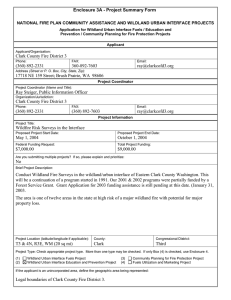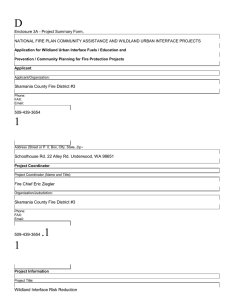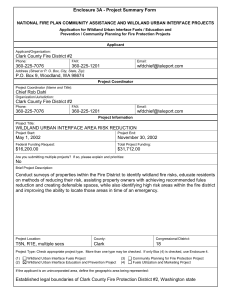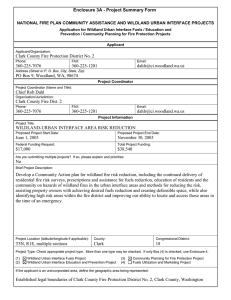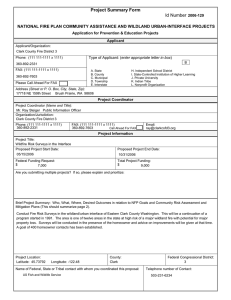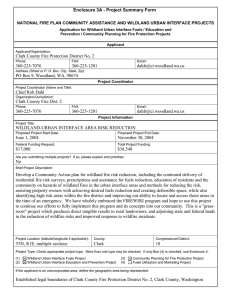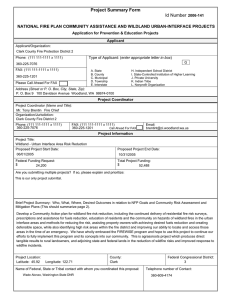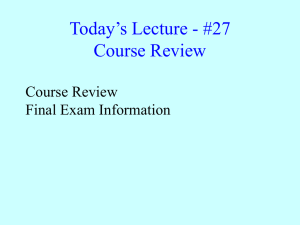Enclosure 3A - Project Summary Form
advertisement
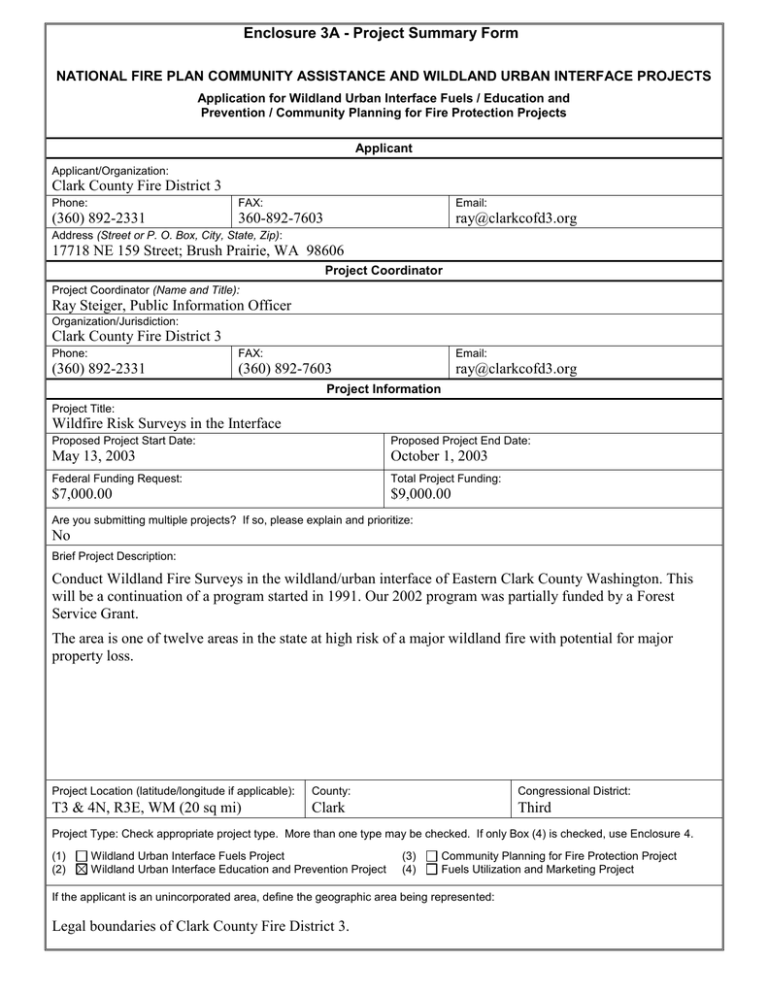
Enclosure 3A - Project Summary Form NATIONAL FIRE PLAN COMMUNITY ASSISTANCE AND WILDLAND URBAN INTERFACE PROJECTS Application for Wildland Urban Interface Fuels / Education and Prevention / Community Planning for Fire Protection Projects Applicant Applicant/Organization: Clark County Fire District 3 Phone: FAX: Email: (360) 892-2331 360-892-7603 ray@clarkcofd3.org Address (Street or P. O. Box, City, State, Zip): 17718 NE 159 Street; Brush Prairie, WA 98606 Project Coordinator Project Coordinator (Name and Title): Ray Steiger, Public Information Officer Organization/Jurisdiction: Clark County Fire District 3 Phone: FAX: Email: (360) 892-2331 (360) 892-7603 ray@clarkcofd3.org Project Information Project Title: Wildfire Risk Surveys in the Interface Proposed Project Start Date: Proposed Project End Date: May 13, 2003 October 1, 2003 Federal Funding Request: Total Project Funding: $7,000.00 $9,000.00 Are you submitting multiple projects? If so, please explain and prioritize: No Brief Project Description: Conduct Wildland Fire Surveys in the wildland/urban interface of Eastern Clark County Washington. This will be a continuation of a program started in 1991. Our 2002 program was partially funded by a Forest Service Grant. The area is one of twelve areas in the state at high risk of a major wildland fire with potential for major property loss. Project Location (latitude/longitude if applicable): County: Congressional District: T3 & 4N, R3E, WM (20 sq mi) Clark Third Project Type: Check appropriate project type. More than one type may be checked. If only Box (4) is checked, use Enclosure 4. (1) (2) Wildland Urban Interface Fuels Project Wildland Urban Interface Education and Prevention Project (3) (4) Community Planning for Fire Protection Project Fuels Utilization and Marketing Project If the applicant is an unincorporated area, define the geographic area being represented: Legal boundaries of Clark County Fire District 3. Enclosure 3B (Page 1 of 3) - Project Narrative Description Applications for funding must include a narrative response that describes the proposal. Please do not submit responses longer than one page, single space, 12-pitch font. Describe project including, but not limited to: project location Address these project implementation items as anticipated outcomes applicable: measures and reporting interagency partners project relationship to community or natural landscape fire plans project time frames and income specify types of activities and equipment used amount or extent of actions (acres, number of homes, etc) environmental, cultural and historical resource requirements Much of the eastern half of Fire District 3 is in the forested foothills of the Cascade Range. The area is relatively accessible and is in private ownership. Clark County is the fastest growing county in the state, and many people are building and living in what has become 1 of 12 areas in the state likely to experience a major wildfire with major property damage and potential loss of life. This project, if funded, will be year eight (8) of a program to contact homeowners in this interface area, and with them conduct a fire risk survey of their home and property Response: The area has many homes tucked away amongst the trees, some with very poor access and many with no visible addresses. The area is also subject to occasional strong drying east winds. We feel a real urgency to inform homeowners of the risks and what they might do to improve their chances of survival. Previous surveys were conducted through grants provided by USDA Forest Service, Washington State Department of Natural Resources and Southwest Washington Independent Forward Thrust (SWIFT). Limited staffing and funding, combined with increasing emergency responses has put a premium on the time of personnel at the Fire District. It is this that requires we hire at least two temporary summer employees to carry out this program. Our goal is to make personal contact with at least 400 homeowners this summer. Valuable statistical information for pre-fire planning purposes was acquired during the course of the surveys. More importantly was the opportunity to educate and inform homeowners in the “interface” about ways they can protect themselves and help defend against wildfire. The one-on-one contact was very effective in convincing homeowners to make necessary fire safety corrections. The primary objective of this project is public education, about the means homeowners can use to protect their property, from wildfire, and to prevent a house fire from spreading into the forest. A secondary objective is for the Fire District to gain a more comprehensive vision of problem areas in the event of fire. Factors relating to evacuation, resources needed, and values involved are critical in pre-fire planning. Benefits are: reduction of loss of natural resources, private property, and human lives. Short-term outcome is many people will become informed as to what they can do to protect their home. A large percent will take immediate steps to correct problems. Long-term outcome is a more fire conscious population and an improvement in conditions in our interface area. This project is relatively easy to administer and can be used by other communities or agencies. We are willing to help others with the development of their own program. The success of this project can be measured by the degree of acceptance of the recommendations given to the homeowner. In previous years, a very high percentage of homeowners contacted in follow up phone calls either had or said they would make the recommended improvements. The personal contact, ease and inexpensive nature of simple improvements, combined to make this program a success in the past. Enclosure 3B (Page 2 of 3) - Project Evaluation Criteria Applications for funding must include narrative responses that address the following four criteria. Within each criterion, subcriteria are listed in descending order of importance. Limit your responses to the areas provided. 1. Reducing Fire Risk. (40 points)) A. Describe how the proposal promotes reduction of risk in high hazard areas or communities, or natural landscapes. B. Describe how the proposed project benefits resources on federal land or adjacent non-federal land, or how it protects the safety of communities. C. To what extent does the project implement or create a cooperative (1) fuels treatment plan or (2) community fire strategy (include evidence of the plan if it already exists)? D. Explain to what extent the affected community or proponent has been involved or plans to involve the affected community in a qualified fuels education program (e.g., FIREWISE). E. Explain how the proposal (1) leads to, enhances or restores a local fire-adapted ecosystem, and/or (2) mitigates or leads to the mitigation of hazardous fuel conditions. F. How will the proposed treatments or programs be maintained in future years? Response: The major emphasis of this program is to reduce fire risk and property loss in the wildland/urban interface area of Fire District 3, and area of approximately 20 square miles. This area has been designated, by the State, as 1 of 12 areas in Washington at high risk of a major fire with potentially major property loss. Reduction of fuels around homes, more fire resistant construction, and better access and address signing will lead to better fire protection for homes and the resources of the land, including wild life. It also reduces chance for fire to spread to nearby state and federal lands. This year’s project goal is to contact and work with 400 homeowners. This program, over the past has allowed us to contact about 4,500 homeowners, a high percentage of whom have or committed to make recommended improvements. In 2001, a concurrent grant from WDNR permitted Fire District 3 to survey over 60 homes for Fire Wise landscaping. About 45 of these homes were visible vegetation modifications and this work was done by a contractor. 2. Increasing local capacity. (30 points) A. How would the proposal improve or lead to the improvement of the local economy in terms of jobs and sustainable economic activity? How many jobs are expected to be created or retained and for how long (please distinguish between essentially yearround and seasonal jobs)? How will this proposal link to toher projects (or proposed projects) to create year-round jobs? B. To what extent will this project be offered to serve as a model for other communities or natural landscapes? C. Will biomass or forest fuels be utilized; if so, in what manner and how much? Response: Over the past years, we have seen a remarkable improvement in defensible space around many of the homes in the interface area, due in large to our effort to inform, educate, and involve the property owners. It is evident that many homeowners have taken steps to improve their chances of survival. We have been gratified by public acceptance of the program in past years. Two local jobs will be created for approximately two months. College students have proven to be a good resource for this project. Based on the estimated population in the wildland-urban interface and adjacent area we believe 15,700 people directly and indirectly benefit from this program. Enclosure 3B (Page 3 of 3) - Project Evaluation Criteria 3. Increasing interagency and intergovernmental coordination. (15 Points) A. Describe how this project implements a local intergovernmental strategy or plan, or creates such a plan. Describe the plan if it already exists. B. Explain the level of cooperation, coordination or strategic planning through a “Local Coordination Group” for wildland fire activities, or among federal, state, tribal, local government and community organizations. List the cooperators (a detailed list of cooperators will be required for projects that are funded). Response: State and Federal agencies, including the Pacific Northwest Interagency Fire Prevention Group developed the guidelines we are using for our surveys. The expertise of these groups in developing the necessary guides for fire safe homes and communities is the technology we transfer to the private land and homeowners. The success of this program in helping to prevent the spread of fire, and reduce fire loss, can have an immense effect on the resources of our, and all other local fire jurisdictions including State and Forest Service. Our program is a partnership between Fire District 3 and our taxpayers and homeowners. We provide the knowledge and encouragement and they provide the labor. 4. Expanding Community Participation. (15 Points) A. To what extent have interested individuals, groups, and communities been provided an opportunity to become informed and involved in this proposal? B. Describe the extent of local support or opposition for the project, including any cost-sharing arrangements. C. What are the environmental, social and educational benefits or concerns of the project? Response: This is a program that Fire District 3 has conducted for eight years, and will continue, as funding is available. We are committed to the program as we have seen the benefits from it. As in the past, our outreach will consist of news releases, and our own Fire District Newsletter that reaches everyone within the District’s boundaries. Included in these news releases are local and Portland based media, who have given the fire district excellent coverage in past years, and hasled to a much better informed public about the need for homeowners to be involved in helping protect their communities from fire. In-kind contributions consist of volunteer time estimated at 80 hours, for program coordination, media contacts, homeowner contacts, and some follow-up after the survey team is finished. It also consists of clerical, benefits, vehicle fuel, uniforms vehicle insurance, supplies, and some managerial salary costs. Enclosure 3C - Project Work Form Tasks Time Frame Responsible Party Media Contacts (Ongoing) May 13, 2003 - October 1, 2003 Ray Steiger Recruit and Hire May 13, 2003 - May 20, 2003 Steve Wrightson Training May 20, 2003 - May 22, 2003 District Personnel Start Homeowner Contacts May 23, 2003 Survey Team Progress Reveiw June 30, 2003 Steve Wrightson Ray Steiger Complete Contacts and Reports August 13, 2003 Survey Team Release Survey Team August 15, 2003 Steve Wrightson Follow up as needed August 15, 2003 - October 1, 2003 District Personnel Top of Form Enclosure 4D - Project Budget Cost Category Description Personnel 650 hours @ $10 hour Supervision, Clerical Subtotal Fringe Benefits Social Security, Ind. Ins. Unemployment Subtotal Travel Vehicle Use 1,450 mi @ $0.345 mi Subtotal Federal Agency Applicant Partner 1 Partner 2 Total $0.00 $0.00 $6,500.00 $1,100.00 $7,600.00 $0.00 $0.00 $200.00 $0.00 $200.00 $0.00 $0.00 $0.00 $500.00 $500.00 $0.00 $0.00 $0.00 $0.00 $0.00 $0.00 $0.00 $500.00 $200.00 $700.00 $0.00 $0.00 $0.00 $0.00 $0.00 $6,500.00 $6,500.00 $1,100.00 $1,100.00 $0.00 $200.00 $0.00 $500.00 $500.00 $200.00 $0.00 $0.00 $0.00 Equipment Subtotal Supplies Printing, Radio Use Uniforms Subtotal $0.00 $0.00 $0.00 $500.00 $200.00 $700.00 $0.00 $0.00 Contractual Subtotal $0.00 $0.00 $0.00 Other Subtotal Total Costs $0.00 $0.00 $0.00 $0.00 $0.00 $0.00 $0.00 $0.00 $7,000.00 $2,000.00 $0.00 $0.00 $9,000.00 Project (Program) Income1 1 Program income is the gross revenue generated by a grant or cooperative agreement supported activity during the life of the grant. Program income can be made by recipients from fees charged for conference or workshop attendance, from rental fees earned from renting out real property or equipment acquired with grant or cooperative agreement funds, or from the sale of commodities or items developed under the grant or cooperative agreement. The use of Program Income during the project period may require prior approval by the granting agency. $0.00
